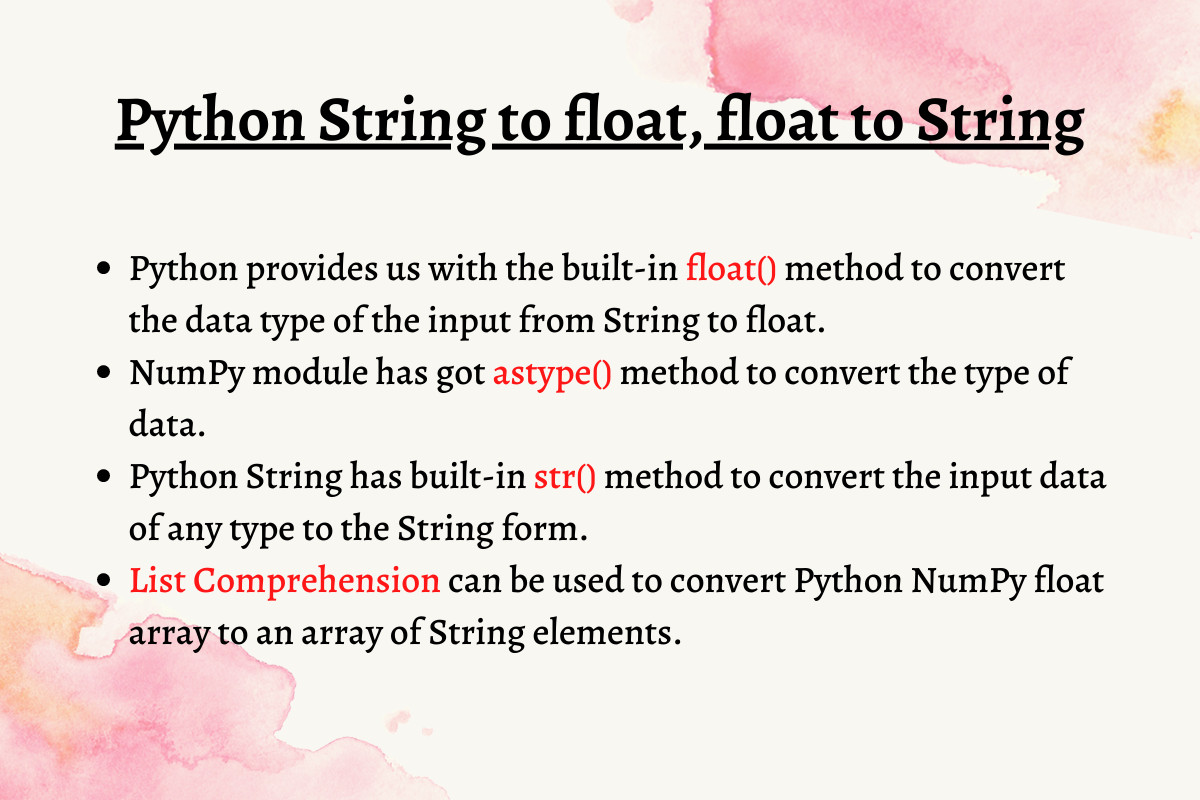

Convert float to string python how to#
How to Convert an Integer and Float to String with the str() Function If you’re insistent on using the encoding and errors parameters, then the object to convert must be a bytes object: my_num = b'45'Ĭonverted_my_num = str(my_num, encoding='utf-8', errors='strict') You only need the number you want to convert: my_num = 45 In this case, you don’t need the encoding and errors at all. This error occurs because you’re using the encoding parameter without providing a bytes object. TypeError: decoding to str: need a bytes-like object, int found If you run the code, you’ll get this error: converted_my_num = str(my_num, encoding='utf-8', errors='errors') You have to comma-separate each of the parameters in the str() function, and the values of both encoding and errors have to be in strings: str(object_to_convert, encoding='encoding', errors='errors')įirst, let’s see how to use all the parameters of the str() function: my_num = 45Ĭonverted_my_num = str(my_num, encoding='utf-8', errors='errors') The values you can use for this parameter include strict, ignore, replace, and others. errors: specifies what to do if decoding fails.encoding: the encoding of the data to convert.If you don’t provide it, str() returns an empty string as the result. object: the data you want to convert to a string.This object the str() function takes can be a float, integer, or even a Boolean.Īpart from the compulsory data to convert to a string, the str() function also takes two other parameters. The str() function takes a compulsory non-string object and converts it to a string.

It’s a built-in function you can use to convert any non-string object to a string. One of those functions we’ll look at in this article is str(). The programming language provides several functions you can use to convert any of these data types to the other. And lastly if no value is passed as an argument it returns 0.Python’s primitive data types include float, integer, Boolean, and string.If the number is outside the range of a floating variable it would return OverflowError.As mentioned earlier, the string should contain a float value else float() would return ValueError.Limitations and Caveats of the above method for converting string to float in Python Similar to float(), values of other data types can be converted into integers and strings using the int(), str(). This function returns the data type of the object. To check the data types you can use the type() function before and after using the float(). The only thing you should keep in mind is that the string should contain a numerical decimal or integer value, only then would the float function be able to convert the string to float.

Convert float to string python code#
Code and Explanation: f1 = float("123.123")Īs you can see the above strings were converted into a floating object. It could contain signs, this would not affect the value returned. In this solution, we use the most common method to convert any data type including a string to float in Python float().

Similar to the above example you would come across similar instances where you would need to convert a string to float in Python. In such cases, you would need to convert numerical values from a string into float/ int before you can use any operations. The most common places where you would come across this is while reading and working with files. However, one frequently looked up method is converting a string object in Python to a floating object. Why would you need to convert a String to Float in Python?Ĭhanging data types in Python is a common practice, and Python has provided us with functions to facilitate this.


 0 kommentar(er)
0 kommentar(er)
